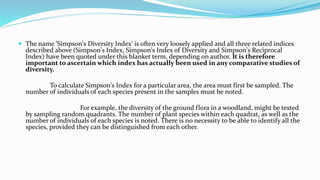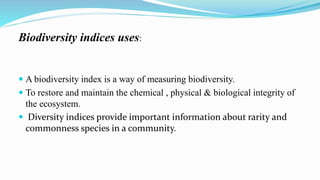This document discusses biodiversity and methods for measuring biodiversity, including through the use of biodiversity indices. It defines biodiversity as the variety of living organisms present in a given ecosystem. It then explains different categories of biodiversity - alpha, beta, and gamma diversity. The document also discusses several commonly used biodiversity indices: species richness, Simpson's index, Shannon-Wiener index, and evenness. It provides formulas for calculating Simpson's and Shannon-Wiener indices and explains how to interpret the results. Overall, the document provides a overview of biodiversity and approaches for quantifying biodiversity through different indices.

























